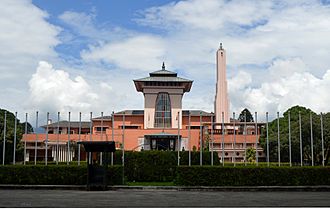Narayanhiti Palace Museum facts for kids
Quick facts for kids Narayanhiti Palace Museum |
|
|---|---|
|
नारायणहिटी दरवार सङ्ग्रहालय (Nepali)
|
|
 |
|
| General information | |
| Town or city | Kathmandu |
| Country | Nepal |
| Construction started | 1963 AD |
| Client | Dhokal Singh Basnyat, King Mahendra, Bir Shumsher JBR |
| Owner | Government of Nepal |
| Technical details | |
| Structural system | Brick and Mortar |
| Size | 38 acres (15 ha) or 753 ropanis |
| Design and construction | |
| Architect | Benjamin Polk |
The Narayanhiti Palace Museum (Nepali: नारायणहिटी दरवार सङ्ग्रहालय) is a public museum in Kathmandu, Nepal. It is located near the Kaiser Mahal and Thamel. This museum was once the Narayanhiti Palace, where the King of Nepal lived and worked.
The palace became a museum in 2008. This happened after a big change in Nepal in 2006, when the country moved from having a king to being a republic. The current palace was built in 1963 by King Mahendra. It has many courtyards, gardens, and buildings.
Contents
What's in a Name?
The name Narayanhiti comes from two words: 'Narayana' and 'Hiti'.
- 'Narayana' is the name of the Hindu god Vishnu. There is a temple dedicated to Vishnu right across from the palace.
- 'Hiti' means "water spout" in the Newar language. There is a famous water spout to the east of the palace's main entrance. This water spout is part of many local stories.
A Palace Through Time
Early Owners of the Land
Before it became a royal palace, the land where Narayanhiti Palace stands had different owners. Important people like Prime Minister Fateh Jung Shah lived there. He was killed in a big event called the Kot massacre in 1846. After that, his family was forced to leave Kathmandu. Other important families also lived in this area.
Later, Colonel Ranodip Singh Kunwar took over the property. He was the brother of Jung Bahadur Rana, another powerful leader. When Ranodip became Prime Minister in 1877, he made the palace much bigger and more beautiful. Sadly, Ranodip was also killed in the palace in 1885 during a sudden change in power.
Becoming a Royal Home
Bir Shumsher Jang Bahadur Rana became Prime Minister after Ranodip. In 1886, Bir Shumsher decided to tear down the old palace. He had a new one built for King Prithvi Bir Bikram Shah. This made Narayanhiti the new official home for the kings of Nepal, moving them from the old Hanuman Dhoka Durbar.
The palace was damaged in a big earthquake in 1934. Two of King Tribhuvan's young daughters died in this earthquake. An engineer named Colonel Surya Jung Thapa helped repair and update the palace.
King Mahendra ordered the palace to be rebuilt again in 1963. An American architect named Benjamin Polk designed the new palace. He used Nepalese architectural styles to make it a symbol for the country. The building was finished in 1969. A special housewarming party was held on February 27, 1970, for the wedding of Crown Prince Birendra.
In 1972, King Mahendra officially declared the palace as government property. He said it was part of his grandmother's dowry.
A very sad event, known as the royal massacre, happened at the palace on June 1, 2001. King Birendra and Queen Aishwarya were among those who died.
From Palace to Museum
After the big changes in Nepal in 2006, the country became a republic. The last king, Gyanendra, left Narayanhiti Palace on June 11, 2008. The palace then became the Narayanhiti Palace Museum. The royal crown jewels were put on display for everyone to see in October 2018.
Inside the Palace Museum
The Narayanhiti Palace Museum covers a large area. It is divided into three main parts:
- The guest wing, where visitors were welcomed.
- The state wing, used for official events.
- The private wing, where the royal family lived.
The palace has 52 rooms, each named after one of the districts of Nepal. The inside of the palace looks like the fancy style from the late Victorian era.
The Reception Hall
The main reception hall is called Kaski Sadan, named after the Kaski District. This hall has two large, stuffed Bengal tigers that look like they are ready to pounce! Kings Mahendra and Birendra hunted these tigers. There are also big paintings of the Shah Kings by artist Amar Chitrakar.
The Kaski Sadan is where the kings of Nepal met with politicians. It was also where new Prime Ministers and other important officials took their oath of office.
The Throne Room
The most important room in the palace is the throne room, called Gorkha Baithak. It is located right above the Kaski Sadan. This room looks like a Hindu temple with a very tall, pagoda-style ceiling. A huge chandelier, 48 feet long, hangs from the 60-foot-high ceiling. The ceiling is supported by four concrete columns that look like Nāga (mythical snakes) and are decorated with Hindu gods and goddesses.
The King's throne was placed under this high ceiling. This is where the king would make important announcements on special occasions. Next to the Gorkha Baithak is a room called Dolpa Sadan. From here, people could secretly watch what was happening in the throne room through a special one-way mirror.
Royal Ceremonies
The Dhanusha Baithak room in the Narayanhiti Palace was used for special ceremonies. The king would give out awards there. It was also used for tika and darshan during the Dashain festival. During this time, the royal family and high-ranking government and military officials would gather there.
Images for kids
-
The Narayan Mandir inside the palace grounds
See also
 In Spanish: Museo del palacio de Narayanhity para niños
In Spanish: Museo del palacio de Narayanhity para niños
- Rana palaces of Nepal
- Madan Puraskar Pustakalaya





